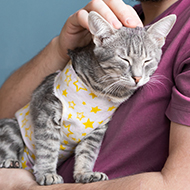PDSA warns against Halloween pet costumes
Costumes can restrict a pet's mobility and ability to look after themselves.
Animal welfare charity PDSA has warned the public against dressing their pets up for Halloween this year.
It is raising awareness of the impact that inappropriate pet clothing can have on a pet’s health and wellbeing.
Many pet costumes are made from a thick fabric, which can restrict a pet’s mobility and their ability to look after themselves. Some costumes may prevent a pet from walking, grooming or going to the bathroom comfortably.
The fabric can impair an animal’s ability to regulate their body temperature, sometimes through multiple layers of material. Smaller parts of a costume might pose a choking hazard, while other parts of a costume can cause injury if they get tangled or caught on surroundings.
PDSA says that dressing up is unnatural for pets and can cause them to become distressed. It is asking that people pay attention to their pet’s body language and behaviour, which will indicate if they are uncomfortable.
Cats may display their discomfort by trying to hide, moving close to the ground, making vocalisations and showing signs of aggression.
Meanwhile, dogs will show their stress through lip licking, yawning and panting. Their body language will be tense, with their ears pinned back and their tail between their legs. They will move away from people or try to look away.
If their owner ignores the signs they are uncomfortable, a dog may resort to aggression.
However, costumes can also mask a dog’s body language, affecting how they communicate with other animals as well as their owners. This can cause them to become confused and stressed, especially if there are misunderstandings around other pets.
Furthermore, PDSA believes that dressing pets up can be humiliating or uncomfortable. They recommend that pets are only given clothing when it will be beneficial to their wellbeing.
This might include a winter coat during cold weather, especially for animals with thin fur or medical conditions, and special boots when a dog’s paws need protecting. A high-vis jacket can be a useful safety device for winter walks.
Surgical vests are also acceptable for protecting healing wounds post-operation, while appropriate therapy tops can help reduce anxiety and stress.
Gemma Renwick, a PDSA veterinary nurse, said: “While fancy dress may be fun for us, it's important to remember that our pets aren’t toys or a Halloween party prop. Dressing them in a way that makes fun of them or puts them in an uncomfortable position is just not a considerate thing to do.
“Our pets are adorable just as they are, and there are other ways to get them involved this Halloween, such as a snuggling up on the sofa for a spooky movie night together.”
Image © Shutterstock



 RCVS Knowledge has called on vet practices to audit their post-operative neutering outcomes.
RCVS Knowledge has called on vet practices to audit their post-operative neutering outcomes.